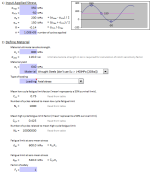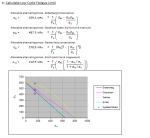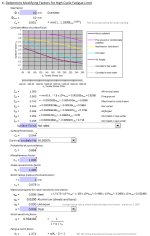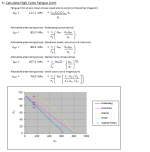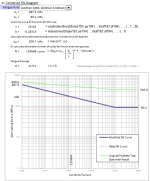Juvinall's Fatigue Life Method.xls
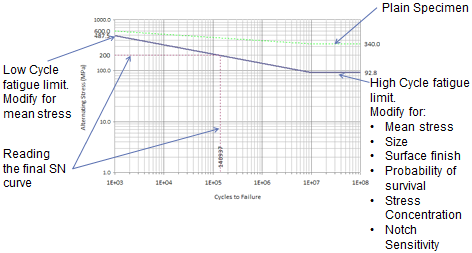
Description
-
Juvinall's Fatigue Life Method (Excel Tool)
Description
Calculation Steps:
- Input Applied Stress: Define the stress applied to the material.
- Define Material: Specify the material under consideration and its properties.
- Calculate Low Cycle Fatigue Limit: Determine the stress level below which the material can endure a relatively large number of load cycles without failure.
- Determine Modifying Factors for High Cycle Fatigue Limit: Identify factors that influence the fatigue limit in high-cycle scenarios.
- Calculate High Cycle Fatigue Limit: Establish the stress level for high-cycle fatigue scenarios.
- Construct SN Diagram: Develop a S-N (Stress-Number of cycles) diagram to visualize the material's fatigue properties.
Purpose of Calculation:
- Generate Wohler/S-N Plots and Goodman Diagram Plots: Visualize the relationship between stress and number of cycles to failure.
- Determine Cut Off Stress: Identify the stress level beyond which the material is expected to fail under cyclic loading.
- Assess Fatigue Strength: Evaluate the material's ability to withstand cyclic loading without failure.
- Establish Fatigue Limit: Identify the maximum stress below which the material can theoretically endure an infinite number of load cycles.
- Analyze Relationship: Explore the relationship between the fatigue limit and the tensile strength of the material.
Calculation Links:
- RoyMech's Fatigue Index
- Open University Material Fatigue
- Fatigue Calculator
- Peterson's Stress Concentration Factors
Units Utilized in Calculation:
- SI & US Calculation Units are applicable.
Calculation Validation:
- Formulae have been validated both graphically and utilizing the XLC add-in for Excel.
Calculation Reference:
- 'Fundamentals of Machine Component Design' by Juvinall & Marshek
- Fatigue Analysis
- Fundamentals of Fatigue
This Excel tool, based on Juvinall's method, facilitates a comprehensive fatigue life analysis, enabling engineers and researchers to assess the fatigue performance of materials under cyclic loading, thereby aiding in the design and evaluation of mechanical components for reliability and safety.
Juvinall's method for fatigue assessment is rooted in the theory of fatigue life prediction and is widely utilized in mechanical design to evaluate the durability of materials and components under cyclic loading. The method is particularly focused on understanding and predicting the number of load cycles a material can withstand before failure occurs due to fatigue. Here's a summarized overview of the theory:
1. Stress-Life Approach:
- S-N Curves: Juvinall's method heavily relies on S-N curves (Stress vs. Number of cycles), also known as Wohler curves, which depict the relationship between the amplitude of cyclic stress (S) and the number of cycles to failure (N) for a particular material.
- Fatigue Limit: The method identifies a fatigue limit, which is the stress level below which a material can theoretically endure an infinite number of load cycles without failure.
2. Low Cycle and High Cycle Fatigue:
- Low Cycle Fatigue (LCF): This involves situations where the material experiences high stress and strain levels, leading to failure after a relatively low number of cycles. LCF is typically associated with plastic deformation.
- High Cycle Fatigue (HCF): This pertains to scenarios where the material is subjected to lower stress levels and fails after a high number of cycles, predominantly involving elastic deformation.
3. Modifying Factors:
- Stress Concentration: Juvinall's method considers stress concentration factors to account for geometric discontinuities that might elevate local stresses and accelerate fatigue failure.
- Surface Finish, Size, and Temperature: The method also incorporates modifying factors that account for the influence of surface finish, component size, and operating temperature on fatigue life.
4. Goodman Diagram:
- Mean and Alternating Stresses: The Goodman diagram is utilized to evaluate the combined effects of mean and alternating stresses on fatigue life.
- Failure Criterion: The diagram helps establish a failure criterion by considering the interplay between mean stress, alternating stress, and material properties (such as yield strength and endurance limit).
5. Fatigue Strength and Endurance Limit:
- Fatigue Strength: Juvinall's method involves determining the fatigue strength of a material, which is the maximum cyclic stress level it can endure for a specified number of cycles without failing.
- Endurance Limit: The method also identifies the endurance limit, which is the maximum stress that a material can withstand for an infinite number of cycles without experiencing failure.
6. Material Properties and Categorization:
- Material Selection: The method emphasizes the importance of material properties, such as tensile strength and hardness, in fatigue assessment.
- Material Categorization: Materials are often categorized based on their behavior in S-N curves, such as ferrous or non-ferrous, to facilitate appropriate fatigue analysis.
7. Design for Fatigue Life:
- Safety Factors: Juvinall's method often incorporates safety factors to ensure that designs are robust and can accommodate unforeseen loading conditions or material imperfections.
- Life Prediction: The method enables engineers to predict the expected life of a component under specified loading conditions, aiding in design optimization and maintenance planning.
In essence, Juvinall's method provides a comprehensive framework for assessing and predicting the fatigue life of materials and components, enabling engineers to design structures that can reliably withstand cyclic loading throughout their intended service life.
Calculation Preview
Full download access to any calculation is available to users with a paid or awarded subscription (XLC Pro).
Subscriptions are free to contributors to the site, alternatively they can be purchased.
Click here for information on subscriptions.

